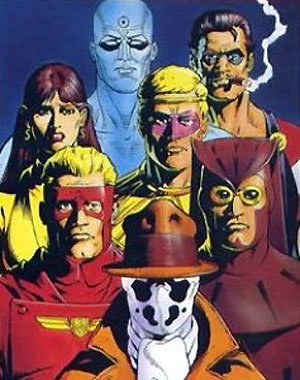A retrospective graphic novel review
Does this seminal comic/graphic novel require introduction. I don't think it does, it is now so ubiquitous to the general comic-book reading, film-going audience. Even if people don't always like it.Source: https://blogger.googleusercontent.com/img/b/R29vZ2xl/AVvXsEgLt45wNlw9SvQpnYFXWlJwnI3rPZddUejka_TfsyKXMkQxXVkC-30nbRz79iy-Uqka_kAceBqvExnGG8Nj8q-P_NMrutu7w0NQP0RpmioeI82O190YGI-rvT6gEWyfWhYc2HSI0CGDJv4v/s1600/Watchmen_Graphic_Novel_cover.jpg
Advantages: Engaging story and characters. A profound graphic novel with depths to analyse.
Disadvantages: Perhaps a little slow-paced for some. Art is dated by today's standards.
"Watchmen" is a series of 12 issues published during 1986, and later collected into a single volume. It was written by Alan Moore and drawn by Dave Gibbons. Both are very prolific British creators. Moore especially, as a large number of his graphic novels have been adapted into (generally bad) Hollywood movies. "Watchmen" itself is seen as one of the greatest graphic novels and revolutionised elements of the comic book industry, and many comics have since tried to emulate its dark nature. In some ways, it was an attempt by Moore to prove that Graphic Novels/Comics could be more substantial, perhaps better, than movies and books. Watchmen was said to be "un-filmable" due to its dense, specific structure and content. Zack Snyder's 2009 release in some ways vindicates this statement, although I believe that his film is an excellent film.
Synopsis: In 1985, superheroes have been made illegal, except those employed by the government or working illegally. As the Cold War approaches Nuclear destruction, the investigation of a murdered adventurer may hold the key to saving the world....or will it?
I could not recommend this Graphic Novel more (and it IS a graphic novel and not simply a "trade paperback"). It can be argued that it is a novel in its own right, as it is a powerful piece of literature that will effect you emotionally at certain points. Although the artwork is dated by today's standards, it fits the story well and is still very good, with great use of colours, and the strict layout of 3x3 panels creates a strange, yet cinematic, effect. Its clever, controlled structure, is one of its most notable and remarkable features. This structure was taken to its extreme in issue 5, "fearful symmetry", where the layout of each page is symmetrical, and its effect is fascinating. Gibbons used it to provide a sense of "authority" and perhaps this reflects the authority of certain characters, such as Ozymandias and Dr. Manhattan, or the authority of the political figures controlling the nuclear bombs?
From top right, clockwise: The Comedian, Ozymandias, Night Owl II, Rorschach,
Captain Metropolis, Silk Spectre II, Dr. Manhattan
Source: http://www.hoodedutilitarian.com/wp-content/uploads/2011/07/watchmen-graphic-novel.jpg
The reader is also left to make up their own decisions about events. Did Ozymandias do the right thing? Will Rorschach's (pronounced Raw Shack) journal be discovered? Personally, I answer No and Yes to those questions, but Moore's aim is to question where the reader's morality lies. Does one side with the morally absolute, yet mentally unstable Rorschach, or with the utilitarian, altruistic, yet ultimately homicidal Ozymandias?
This extends into one of Watchmen's other notable features. "The Tales of the Black Freighter" is a piece of metafiction; a "comic-within-a-comic", a "story-within-a-story". It is designed to reflect or as a foil to the actions in the main story. It provides a parallel to the plot, and, although Moore states that is specifically refers to the "villain" Ozymandias, it can relate to Rorschach's death and Dr. Manhattan's self-exile. Ultimately any interpretation could be the correct one, but the way you interpret it reflects your own opinions and feelings about these characters and the moral questions at the heart of the story.
The way Moore gives each character their flaws is fascinating. Even the perfect human, Adrian Veidt, seems detached and aloof, perhaps bored, during his lengthy monologue. The fall of Dr. Manhattan, a man with ultimate power that does ultimately corrupt, leaving him with little emotion and having lost nearly all empathy.
The use of symbolism is effective. I cannot understand the meaning of some of it, but it is a novel that deserves to be read more than once. Moore has created memorable characters, such as Rorschach, the ultimate street vigilante, as a logical extreme of the Batman style of superhero. Certain sections contain relatively little dialogue, and are read too fast, and there is room for more action, but the lack of sound effects and speech bubbles have a surprising effect, making these fight scenes more realistic and visceral. Looking at comics today, the impact left by Watchmen is clear.
All in all, a great read, with so many touches that bind it all together. It is visually engaging and hard to tear your eyes away from. Littered with references and symbolism which one must track down, it is ultimately very satisfying. Read it before you buy the movie, and if you've already seen the movie, buy this classic in order to gain a deeper and more profound understanding of the Watchmen universe, that, in many ways, was too complex to be put on the screen.
Summary: It exemplifies all that is good and great about the comic book medium.


No comments:
Post a Comment